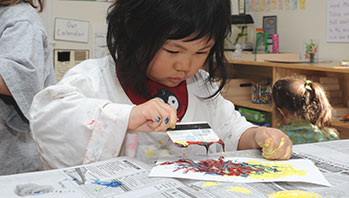- bucket of water
- various materials that will withstand water (flower petal, leaves, foam pieces, toothpicks, beans, etc.)
- paper plates
- glue
- paper towels
- clothespins (optional)
- float
- sink
MA Standards:
Language/L.PK.MA.5.aL Demonstrate understanding of concepts by sorting common objects into categories (e.g., sort objects by color, shape, or texture).
Language/L.PK.MA.6: Use words and phrases acquired through conversations, listening to books read aloud, activities, and play.
MA Draft STE Standards:
Physical Sciences/Matter and Its Interactions: Structure and Properties of Matter/PS1.A: Describe, compare, sort and classify objects based on observable physical characteristics, uses, and whether it is manufactured as part of their classroom play and investigations of the natural and human-made world.
Head Start Outcomes:
Logic and Reasoning/Reasoning and Problem Solving: Classifies, compares, and contrasts objects, events, and experiences.
PreK Learning Guidelines:
English Language Arts/Language 4: Engage in play experiences that involve naming and sorting common words into various classifications using general and specific language.
Float and Sink Art

© Commonwealth of Massachusetts, Department of Early Education and Care (Jennifer Waddell photographer). All rights reserved.
Skill Focus: Color Recognition, Creative Expression, Predicting, Fine Motor Skills, Vocabulary
Educator Prep: For each child, prepare two sheets of paper toweling with the labels: “Float” and “Sink” and two paper plates. On each paper plate, draw a dark circle around the middle so children can glue their float items inside the circle and their sink items along the edge of the plate (or vice versa).
Tell children they are going to choose a number of objects to test if they float or sink. Say, After you choose your objects, you will predict whether it floats or sinks, and talk about why you think so. Then test each one by placing them one at a time in the water. Explain that once they determine whether the object floats or sinks they will place it on a “sinks” or “floats” paper towel to dry. Then they will create their “Float and Sink” paper plates and talk about how what happened compares to their predictions.
- Have children choose 5–10 materials.
- Invite them to predict whether they think each object will float or sink and why they think so.
- Have children place the objects in the water one at a time and decide whether it floats or sinks.
- Have them move the object to the appropriate paper towel to dry.
- Once all the objects have been tested, have children glue their floating items on the glue floating items on the outside of the plate and sinking items on the inside.
- Have each child write or dictate his or her name on the plate.
You may want to thread a piece of yarn through the paper plate once the glue has dried and hang the creations around the room.
